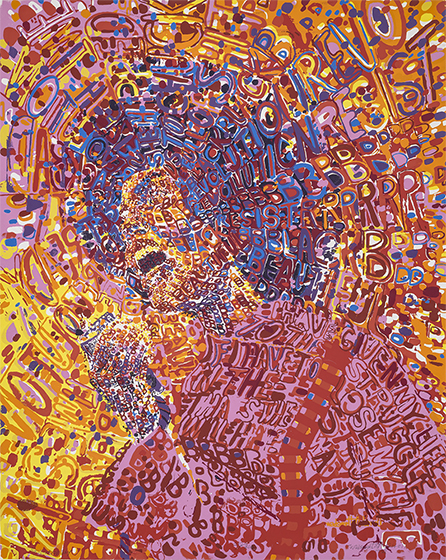Dr. Martin Luther King Jr. and Malcolm X may have had very different ideas of the best way to fight discrimination, oppression, and violence directed at African American people, but the cause they served was the same. They fought for freedom for Black Americans to fulfill their potential, participate in all aspects of American society and American life, and pursue their American Dream on equal footing with white Americans. Together they made great inroads toward that freedom, which we celebrate, even while recognizing that there is still much work to do to achieve that ultimate goal.
Our upcoming exhibition, Soul of a Nation: Art in the Age of Black Power, opening on February 3, 2018, presents a fascinating and impactful look at the artists who were working through the 1960s, ’70s and into the early ’80s, when the Black Power movement was at its peak. Some of the artists represented in the exhibition felt it was their duty to take on issues of discrimination and violence directly: creating images of protest or images of pride in their Black communities. Others felt differently, and worked in abstract ways, expressing ideas and emotions in a non-representational way. Some artists strove to present a distinctly Black Art, while others rejected that idea. All of these many different approaches are included in this eye-opening and moving exhibition.
Crystal Bridges is very pleased to be one of only two venues in North America to host this important show, which was developed as a collaboration between our museum and the Tate in London, England. After the exhibition closes at Crystal Bridges on April 23, it will travel to the Brooklyn Museum, New York.

Wadsworth Jarrell, born 1929
Revolutionary, 1972
Screen print on paper
Courtesy Lusenhop Fine Art
Wadsworth Jarrell was one of the founding members of AfriCOBRA, an African American art collective whose aim was to uplift African American people and culture.
“AFRICOBRA wasn’t about race at all, we were about heritage, and that is the difference. We were not about protest, it wasn’t about any of that kind of stuff, it wasn’t about the Ku Klux Klan, and pointing out look what they did to us. We were moving forward. We were showing the positive area of our heritage, you know, that’s where we were.” — Wadsworth Jarrell

Cliff Joseph, born 1922
Blackboard, 1969
Oil on canvas
Aaron Galleries, Glenview, Illinois
“I would not say that there is black art per se. I believe in art. There is, however, a black experience in art; I think every culture has its own experience which the artist of that culture brings to his work. Certainly the black man in America has had a very unique experience among minority groups which he finds is important – certainly I find it important in art – to talk about it, to tell about it, to depict in his work.” — Cliff Joseph

Dawoud Bey, Born 1953
A Boy in front of the Loew’s 125th Street Movie Theater, 1976
Gelatin silver print
The Art Institute of Chicago
“Black people have been klled for directing their gaze at the wrong person. I want my subjects to reclaim their right to look, to see, to be seen.” –Dawoud Bey

Melvin Edwards, born 1937
Afro-Phoenix #2, 1963
Welded steel
Courtesy of the artist and Alexander Gray Associate, New York/Stephen Friedman Gallery, London
“One of my discussions within the black art community was with people who said, “Abstraction can’t be black.” Well, I don’t know why not. It always was. Besides, we do new and experimental stuff with music, with any number of other things. Why not with art?” –Melvin Edwards

William T. Williams, born 1942
Trane, 1969
Acrylic on canvas
The Studio Museum in Harlem, New York.
“My art is about my experience which, by nature, makes it about other people’s experience . . . I’m trying to evoke human response. My demographic is the human arena. I hope my work is about celebration, about an affirmation of life in the face of diversity, to reaffirm that we’re human, that we’re alive, that we can celebrate existence.” — William T. Williams

Betye Saar, born 1926
Rainbow Mojo, 1972
Acrylic on leather
paul-michael diMeglio
“There has been an apparent thread in my art that weaves from early prints of the 1960’s through later collages and assemblages and ties into the current installations. That thread is a curiosity about the mystical.” — Betye Saar
Learn more about Soul of a Nation here.




